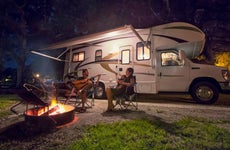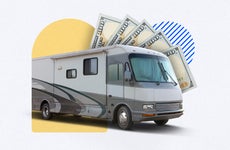How to get an RV loan: 3 steps for financing an RV

The Bankrate promise
At Bankrate we strive to help you make smarter financial decisions. While we adhere to strict , this post may contain references to products from our partners. Here's an explanation for .
Key takeaways
- You can get an RV loan from banks, credit unions, online lenders and at some RV-specific dealerships.
- To qualify for an RV loan, you'll need to satisfy certain credit score, income and credit history requirements, in addition to lender-specific requirements.
- To improve your chances of approval, make sure your finances are in order and research lenders to find options that cater to your situation.
Recreational vehicles — or RVs — can cost anywhere from under $10,000 to over $500,000, depending on the class, model and condition. RV loans can be a great way to finance such a large purchase.
These loans are typically available through online lenders, banks, credit unions and RV dealerships.
The RV loan application process is similar to applying for an auto loan, but getting approved is often harder. That’s because lenders tend to have stricter requirements for these types of loans, given their large amounts.
Steps for financing an RV
Wondering how to get a loan for an RV? It’s similar to getting any other type of loan. To maximize your chances of approval, follow these steps before applying:
- Check your credit score. Lenders typically require a score of 670 or higher. If your score is lower, try improving it before submitting a loan application.
- Identify the type of RV you want to purchase. This is important because it will determine how much you’ll need to borrow. You may also consider different lenders depending on whether it is new or used.
- Secure the funds for your down payment. Though not required by all lenders, this is typically 10 to 20 percent of the RV’s purchase price.
- Compare lenders. Look at eligibility requirements, interest rates and repayment terms to come up with a list of viable options.
1. Prequalify with multiple lenders
Before submitting a full application, get quotes from the lenders you’ve researched. This process, known as prequalification, will not hurt your credit. It helps you determine your purchasing power and possible monthly payment before you shop.
If you are purchasing from a dealer, look for one that works with multiple lenders. This may increase your chances of being matched with a competitive offer.
2. Complete an application
Once you’ve settled on a lender, complete and submit your full application. Although this may vary from one lender to the next, you’ll likely be asked to provide the following:
- Your full name and date of birth.
- Proof of identity, such as a passport or another official ID.
- Your address and phone number.
- Proof of address, such as a utility bill, an insurance contract or a lease agreement.
- Your Social Security number.
- Your employer’s contact information.
- Proof of income, such as copies of tax returns, pay stubs or W-2s.
3. Sign the loan agreement
The loan agreement outlines the loan terms, including your payment amount and due date. Review the fine print and sign. Depending on the lender, the funds may be deposited into your account as soon as the next day.
Getting approved for an RV loan: Factors to consider
RVs are expensive and often labeled luxury items. So, financing an RV can come with more stringent qualifications than a car loan, often mirroring those of qualifying for a mortgage.
Credit score
As with applying for any type of consumer borrowing, a solid FICO credit score is an important part of your qualifications. Lenders use credit scores to gauge your level of credit risk or likelihood of repaying the loan.
Most lenders require a FICO score of at least 670 to qualify for an RV loan. However, some will allow FICO scores below that threshold. To secure the lowest rates, you’ll need a credit score in the mid-700s or higher. Otherwise, you could end up with a hefty interest rate.
Before starting your application, check your credit reports with all three credit bureaus — Experian, Equifax and TransUnion — so you know about any negative marks. That way, you can take any steps needed to improve your score.
A free copy of your credit report from all three bureaus is available weekly from AnnualCreditReport.com.
Can I get an RV loan with bad credit?
It’s possible to qualify for an RV loan with a lower credit score. Some lenders may still approve loans for buyers with a credit score as low as 600, but this typically comes with higher interest rates and fees.
Shop around to find the best offer regardless of your credit score.
Income
When applying for an RV loan, the lender will ask you to provide proof of income. Lenders may also ask you to produce statements of debts to calculate your debt-to-income ratio (DTI).
Your DTI shows how much of your monthly income goes to paying your debts. Lenders typically want to see that your DTI will stay under 36 percent even after you take on an RV loan. A low DTI indicates you can likely afford additional debt.
Use Bankrate’s personal loan calculator to help determine how much you can reasonably afford.
Cost
On the low end, you can find a towable pop-up camper for as low as $5,000. High-end new RVs can cost more than $1 million. Before you start shopping, figure out what you want in an RV and what you can reasonably afford.
The age of the RV will also impact its price. A new RV will naturally cost more than a used model. But while it may come with sleek features, you will likely face steep depreciation, just like with a new car.
On the other hand, a used RV will have similar features but cost significantly less. You can also find RVs that are decades old. They won’t have as cushy of features as a recent model, but they will cost significantly less.
| New | Used | |
|---|---|---|
| Class A | $50,000 to $300,000 | $30,000 to $175,000 |
| Class B | $70,000 to $150,000 | $40,000 to $115,000 |
| Class C | $50,000 to $150,000 | $30,000 to $75,000 |
| Travel trailer | $20,000 to $75,000 | $10,000 to $50,000 |
| Fifth wheel | $35,000 to $125,000 | $30,000 to $100,000 |
Source: Camper FAQs
Credit history
While credit history requirements vary by lender, every lender cares about your track record of borrowing. This includes making on-time payments on credit cards and any installment loans, such as student loans, personal loans or a mortgage.
Lenders balk at late or missed payments and defaults. The fewer you have, the better.
Lender-specific requirements
Approval requirements typically vary by lender. The most common variations include minimum credit score and income requirements.
Some lenders may also ask questions about how you plan to use the RV (as a primary residence or as a vacation home). They may also want to know about the vehicle’s condition.
To avoid unnecessary rejections, check this on each lender’s website or by contacting customer support before applying.
The bottom line
Many lenders can help with financing an RV, whether new or used. To improve your approval odds, assess your credit score and income before proceeding with a formal application. Also, shop around and get prequalified with multiple lenders to find the best deal available to you.
Related Articles



